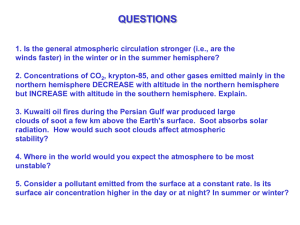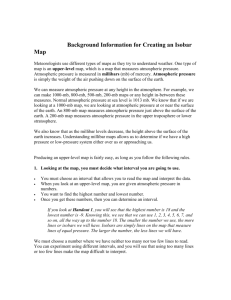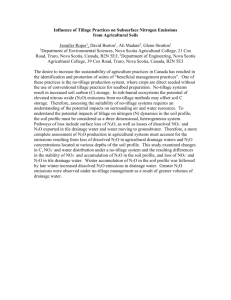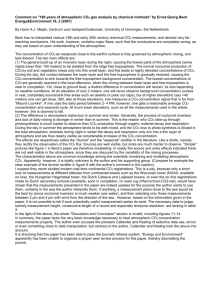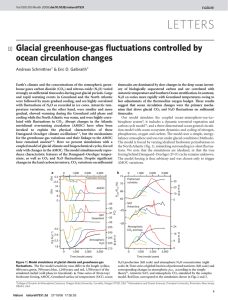data source
advertisement
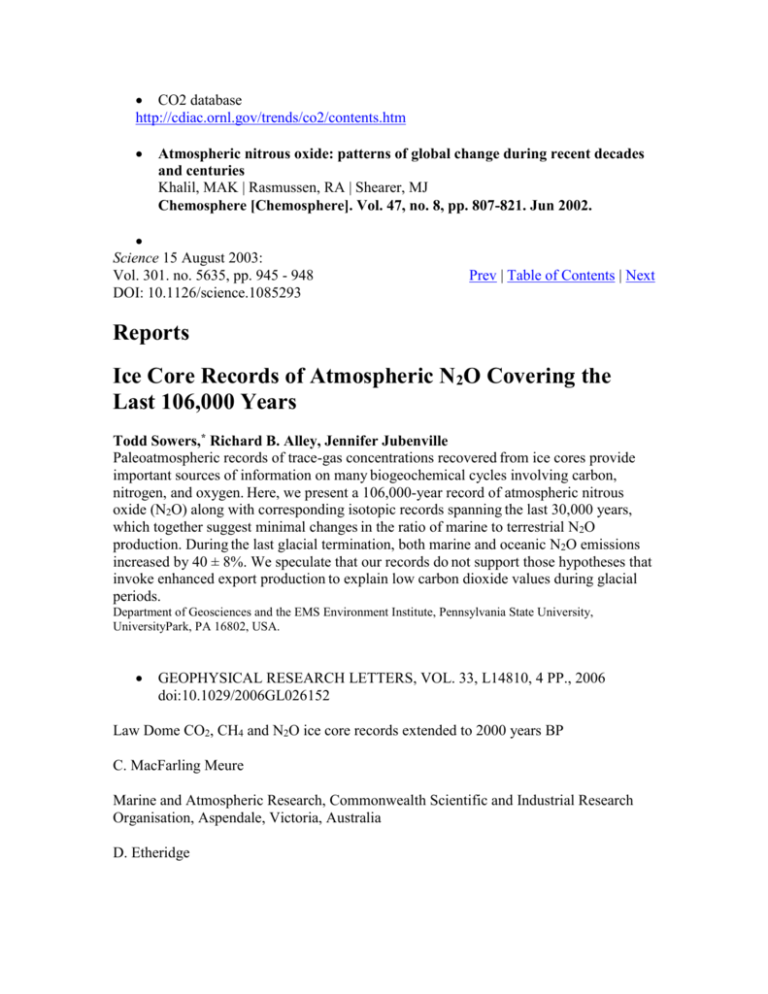
CO2 database http://cdiac.ornl.gov/trends/co2/contents.htm Atmospheric nitrous oxide: patterns of global change during recent decades and centuries Khalil, MAK | Rasmussen, RA | Shearer, MJ Chemosphere [Chemosphere]. Vol. 47, no. 8, pp. 807-821. Jun 2002. Science 15 August 2003: Vol. 301. no. 5635, pp. 945 - 948 DOI: 10.1126/science.1085293 Prev | Table of Contents | Next Reports Ice Core Records of Atmospheric N2O Covering the Last 106,000 Years Todd Sowers,* Richard B. Alley, Jennifer Jubenville Paleoatmospheric records of trace-gas concentrations recovered from ice cores provide important sources of information on many biogeochemical cycles involving carbon, nitrogen, and oxygen. Here, we present a 106,000-year record of atmospheric nitrous oxide (N2O) along with corresponding isotopic records spanning the last 30,000 years, which together suggest minimal changes in the ratio of marine to terrestrial N2O production. During the last glacial termination, both marine and oceanic N2O emissions increased by 40 ± 8%. We speculate that our records do not support those hypotheses that invoke enhanced export production to explain low carbon dioxide values during glacial periods. Department of Geosciences and the EMS Environment Institute, Pennsylvania State University, UniversityPark, PA 16802, USA. GEOPHYSICAL RESEARCH LETTERS, VOL. 33, L14810, 4 PP., 2006 doi:10.1029/2006GL026152 Law Dome CO2, CH4 and N2O ice core records extended to 2000 years BP C. MacFarling Meure Marine and Atmospheric Research, Commonwealth Scientific and Industrial Research Organisation, Aspendale, Victoria, Australia D. Etheridge Marine and Atmospheric Research, Commonwealth Scientific and Industrial Research Organisation, Aspendale, Victoria, Australia C. Trudinger Marine and Atmospheric Research, Commonwealth Scientific and Industrial Research Organisation, Aspendale, Victoria, Australia P. Steele Marine and Atmospheric Research, Commonwealth Scientific and Industrial Research Organisation, Aspendale, Victoria, Australia R. Langenfelds Marine and Atmospheric Research, Commonwealth Scientific and Industrial Research Organisation, Aspendale, Victoria, Australia T. van Ommen Department of the Environment and Heritage, Australian Antarctic Division, and Antarctic Climate and Ecosystems CRC, Hobart, Tasmania, Australia A. Smith Australian Nuclear Science and Technology Organisation, Menai, New South Wales, Australia J. Elkins NOAA, Earth System Research Laboratory, Boulder, Colorado, USA New measurements of atmospheric greenhouse gas concentrations in ice from Law Dome, Antarctica reproduce published Law Dome CO2 and CH4 records, extend them back to 2000 years BP, and include N2O. They have very high air age resolution, data density and measurement precision. Firn air measurements span the past 65 years and overlap with the ice core and direct atmospheric observations. Major increases in CO2, CH4 and N2O concentrations during the past 200 years followed a period of relative stability beforehand. Decadal variations during the industrial period include the stabilization of CO2 and slowing of CH4 and N2O growth in the 1940s and 1950s. Variations of up to 10 ppm CO2, 40 ppb CH4 and 10 ppb N2O occurred throughout the preindustrial period. Methane concentrations grew by 100 ppb from AD 0 to 1800, possibly due to early anthropogenic emissions. Received 26 February 2006; accepted 16 May 2006; published 21 July 2006. Citation: MacFarling Meure, C., D. Etheridge, C. Trudinger, P. Steele, R. Langenfelds, T. van Ommen, A. Smith, and J. Elkins (2006), Law Dome CO2, CH4 and N2O ice core records extended to 2000 years BP, Geophys. Res. Lett., 33, L14810, doi:10.1029/2006GL026152. Nature 360, 449 - 451 (03 December 1992); doi:10.1038/360449a0 Ice-age atmospheric concentration of nitrous oxide from an Antarctic ice core Markus Leuenberger & Ulrich Siegenthaler Physics Institute, University of Bern, Sidlerstrasse 5, 3012 Bern, Switzerland INCREASING anthropogenic emissions of greenhouse gases are expected to influence the Earth's climate, but the mechanisms for this are not yet fully understood. One way to determine the effect of such gases on climate is to study their atmospheric concentrations during periods of past climate change, such as glacial to interglacial transitions. Previous studies on polar ice cores showed that the concentrations of the greenhouse gases CO2 and CH4 were significantly reduced during the last glacial period relative to Holocene values1–5. But no comparable studies have been reported for nitrous oxide (N2O), which is the next most important greenhouse gas and also affects stratospheric ozone6,7 and, potentially, the oxidative capacity of the troposphere8. Here we report results from Antarctic ice cores, showing that the atmospheric N2O concentration was about 30% lower during the Last Glacial Maximum than during the Holocene epoch. Our data also show that present-day N2O concentrations are unprecedented in the past 45 kyr, and hence provide evidence that recent increases in atmospheric N2O are of anthropogenic origin. Title: Nitrous oxide: trends and global mass balance over the last 3000 years Authors: Khalil, M. A. K.; Rasmussen, R. A. Publication: Annals of Glaciology, vol.10, pp.73-79 Publication Date: 00/1988 Origin: WEB Bibliographic Code: 1988AnGla..10...73K http://earthobservatory.nasa.gov/Features/Paleoclimatology_IceCores/ http://www.agu.org.proxy.library.carleton.ca/journals/gl/gl0614/2006GL026152/ (accessed through Carleton University account to this article: GEOPHYSICAL RESEARCH LETTERS, VOL. 33, L14810, doi:10.1029/ 2006GL026152, 2006 Law Dome CO2, CH4 and N2O ice core records extended to 2000 years BP C. MacFarling Meure, D. Etheridge, C. Trudinger, P. Steele, and R. Langenfelds Marine and Atmospheric Research, Commonwealth Scientific and Industrial Research Organisation, Aspendale, Victoria, Australia)


